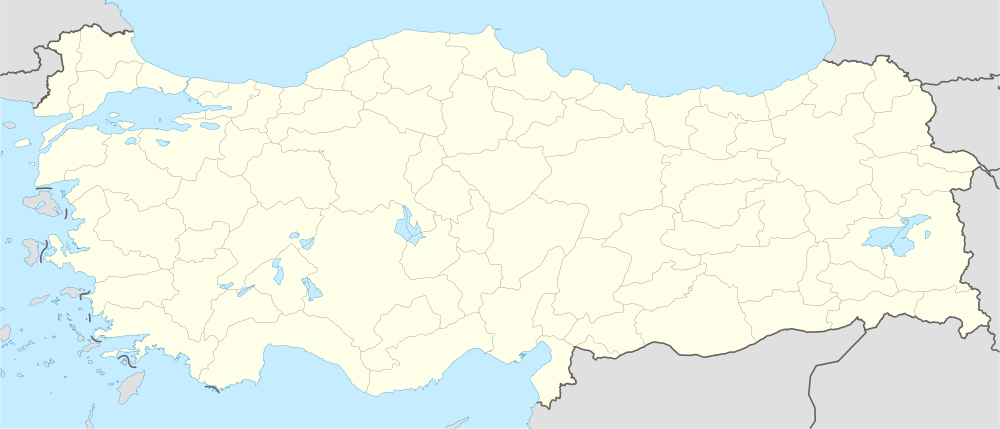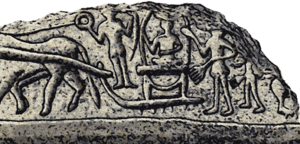Melid
Coordinates: 38°22′55″N 38°21′40″E / 38.38194°N 38.36111°E Melid (Hittite: Malidiya[1] and possibly also Midduwa;[2] Akkadian: Meliddu;[3] Urartian: Melitea; Latin: Melitene) was an ancient city on the Tohma River, a tributary of the upper Euphrates rising in the Taurus Mountains. It has been identified with modern Arslantepe near Malatya, Turkey.
| Arslantepe | |
|---|---|
 Arslantepe Location in Turkey | |
| Coordinates: 38°22′55″N 38°21′40″E / 38.38194°N 38.36111°E |
History
The site has been inhabited since the development of agriculture in the fertile crescent dating to the Uruk period. From the Bronze Age the site became an administrative center of a larger region in the kingdom of Isuwa. The city was heavily fortified, probably due to the Hittite threat from the west. The Hittites conquered the city in the fourteenth century BC. In the mid 14th century BC, Melid was the base of the Hittite king Suppiluliuma I on his campaign to sack the Mitanni capital Wassukanni.
After the end of the Hittite empire, from the 12th to 7th century BC, the city became the center of an independent Luwian Neo-Hittite state of Kammanu. A palace was built and monumental stone sculptures of lions and the ruler erected.
The encounter with the Assyrian king of Tiglath-Pileser I (1115-1077 BC) resulted in the kingdom of Melid being forced to pay tribute to Assyria. Melid remained able to prosper until the Assyrian king Sargon II (722-705 BC) sacked the city in 712 BC.[4] At the same time, the Cimmerians and Scythians invaded Anatolia and the city declined.
Archaeology

Arslantepe was first investigated by the French archaeologist Louis Delaporte from 1932 to 1939. [5] [6] [7] From 1946 to 1951 Claude F.A. Schaeffer carried out some soundings. The first Italian excavations at the site of Arslantepe started in 1961, and were conducted under the direction of Professors Piero Meriggi and Salvatore M. Puglisi until 1968. [8] [9] [10] The choice of the site was initially due to their desire of investigating the Neo-Hittite phases of occupation at the site, period in which Malatya was the capital of one of the most important reigns born after the destruction of the Hittite Empire in its most eastern borders. Majestic remains of this period were known from Arslantepe since the 30s, brought to light by a French expedition. The Hittitologist Meriggi only took part of the first few campaigns and later left the direction to Puglisi, a palaeoethnologist, who expanded and regularly conducted yearly investigations under regular permit from the Turkish government. Alba Palmieri took over the supervision of the excavation during the 1970s. [11] [12] Today the archaeological investigation is led by Marcella Frangipane. [13]
Notes
- ↑ "Melid." Reallexikon der Assyriologie. Accessed 12 Dec 2010.
- ↑ KBo V 8 IV 18. Op. cit. Puhvel, Jaan. Trends in Linguistics: Hittite Etymological Dictionary: Vol. 6: Words Beginning with M. Walter de Gruyter, 2004. Accessed 12 Dec 2010.
- ↑ Hawkins, John D. Corpus of Hieroglyphic Luwian Inscriptions. Vol. 1: Inscriptions of the Iron Age. Walter de Gruyter, 2000.
- ↑ J. D. Hawkins, Assyrians and Hittites, Iraq, vol. 36, no. 1/2, pp. 67-83, 1974
- ↑ Louis De Laporte, Malatya. La Ville et le Pays de Malatya, Review Hittites et Asian, vol. 2, no. 12, pp. 119-254, 1933
- ↑ Louis De Laporte, Malatya - Céramique du Hittite Recent, Review Hittites et Asian, vol. 2, no. 15, pp. 257-285, 1934
- ↑ Louis De Laporte, La Troisième Campagne de Fouille è Malatya, Review Hittites et Asian, vol. 5, no. 34, pp. 43-56, 1939
- ↑ S.M. Puglisi and P. Meriggi, Malatya I: Rapporto preliminare delle Campagne 1961 e 1962, Orientis Antiqui Collectio, vol. 7, 1964
- ↑ E. Equini Schneider, Malatya II: Rapporto preliminare delle Campagne 1963-1968. Il Livello Romano Bizantino e le Testimonianze Islamiche, Orientis Antiqui Collectio, vol. 10, 1970
- ↑ P.E. Pecorella, Malatya III: Rapporto preliminare delle Campagne 1963-1968. Il Livello Eteo Imperiale e quelli Neoetei, Orientis Antiqui Collecti, vol. 12, 1975
- ↑ A. Palmieri, Excavations at Arslantepe (Malatya), Anatolian Studies, vol. 31, pp. 101-119, 1981
- ↑ Alba Palmieri, "Arslantepe Excavations,1982," Kazi Sonuçlari Toplantisi, vol. 5, pp. 97-101, 1983
- ↑ Historical Dictionary of the Hittites, pp 185-186
See also
- Cities of the Ancient Near East
- Short chronology timeline
References
- Burney, Charles Allen (2004). Historical Dictionary of the Hittites. Scarecrow Press. ISBN 0-8108-4936-4.
- Louis De Laporte, La porte des lions, 1940